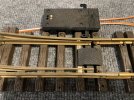I'm a new member but a long time LGB train collector and operator.
The leading and trailing wheels on my 2-8-2 LGB Mikado's are derailing on a consistent basis when navigation points. The leading truck appears to bounce at the frog and jump the rail. The larger and more consistent problem is that when the engine is passing straight through a right hand switch the drive wheels and the trailing truck (wheels) appear to push the tongue open which either causes the tender to be diverted to the right line which derails it, or the tongue is left half open which will cause the next train that passes through to derail.
Has anyone else seen this problem? I have two Mikado's and they both cause this problem. I'm thinking about adding lead tape or a spring to apply more pressure to the trucks. Any additional thoughts on how to solve this problem would be appreciated. My steam engines are on the shelf for now.
The image below show the switch after the Mikado and Tender pass through.
The leading and trailing wheels on my 2-8-2 LGB Mikado's are derailing on a consistent basis when navigation points. The leading truck appears to bounce at the frog and jump the rail. The larger and more consistent problem is that when the engine is passing straight through a right hand switch the drive wheels and the trailing truck (wheels) appear to push the tongue open which either causes the tender to be diverted to the right line which derails it, or the tongue is left half open which will cause the next train that passes through to derail.
Has anyone else seen this problem? I have two Mikado's and they both cause this problem. I'm thinking about adding lead tape or a spring to apply more pressure to the trucks. Any additional thoughts on how to solve this problem would be appreciated. My steam engines are on the shelf for now.
The image below show the switch after the Mikado and Tender pass through.


